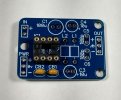Life’s exigencies have preventing forum activity for a bit, but I just had to make progress on addressing a balanced interface to my amp, as a step to a future insertion of a MiniDSP Flex to use as a system PEQ and perhaps also to integrate future subwoofers. Here’s where I had left it, in the MiniDSP thread:
https://www.audiosciencereview.com/...idsp-flex-review-audio-dsp.30804/post-1092076
I had already purchased a pair of Sparkfun Outsmarts differential amp modules, described at this link:
https://learn.sparkfun.com/tutorials/that-ingenius-and-outsmarts-breakout-hookup-guide
My plan had been to use the +/-15 V rails I thought I would find in my preamp. But the schematic I was working from was for something different than my B&K Sonata MC-101. It has +/- 28 VDC points. That’s too much for the Outsmarts modules that had been suggested to me in that thread. But I found a no-name DC-DC bipolar power supply that would accept any input from 15 to 36 VDC and provide +/-12 VDC.
Had I any intelligence, I would have tested that power supply thoroughly with a bulletproof lab power supply. I do not have any intelligence. I connected it to the 28 VDC point in the B&K board, saw a tiny spark, and fubarred my preamp
Each side of the 28 VDC regulation circuit uses a TIP31A power transistor, a 2N5210 transistor, a zener diode, and associated resistors. I removed the two transistors for testing, and the 2N5210 was definitely shorted. I found one of those and also a TIP31A and installed new replacements. That added a month to the project sourcing those parts—Mouser and Digikey were both out of stock but I found them at a supplier in Florida. But my work travel precluded installing them until this evening. Problem solved—the B&K is now unfubarred.
That’s when I decided the advice I’d been given in the above thread was correct—just build a standalone device with its own power supply.
So, in addition to the Outsmarts modules, I found a Meanwell +/-15 VDC switcher, and bought a case and the bits needed to stick it all together. Here’s the result:
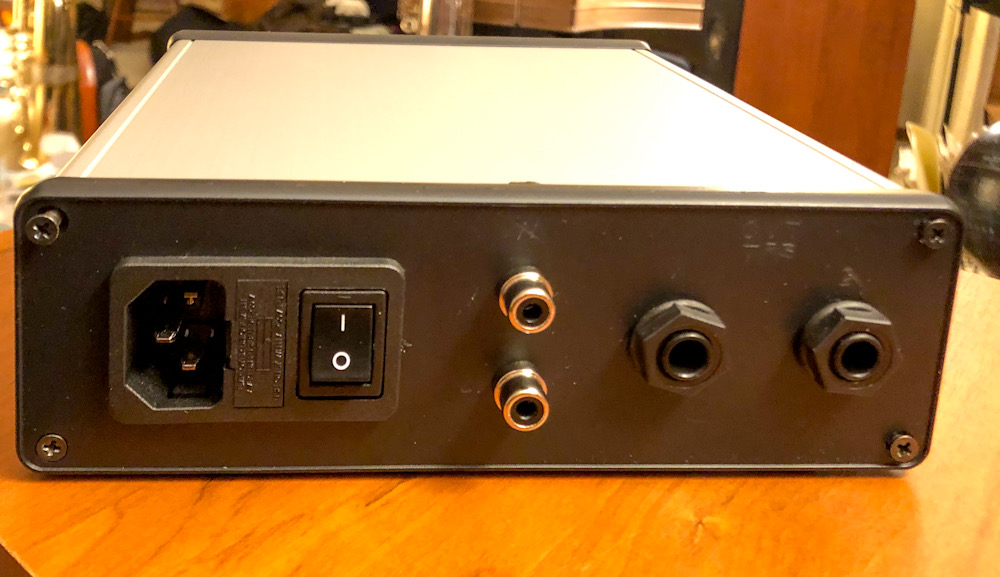
This is what I call a minimalist control panel.
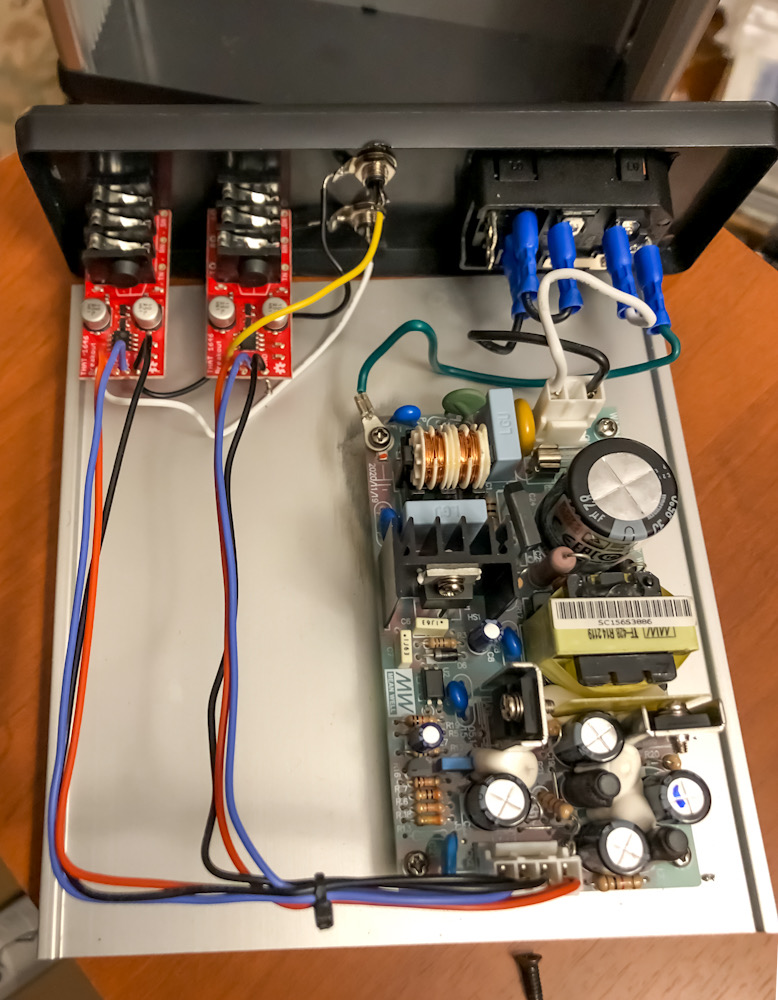
The two Outsmarts modules are at left, and the power supply is at right. I used an IEC receptacle with fuse and power switch. I ran earth safety ground to the grounding point on the power supply, which grounds the case through metal standoffs. (Yes, I wire-brushed the anodizing off.)
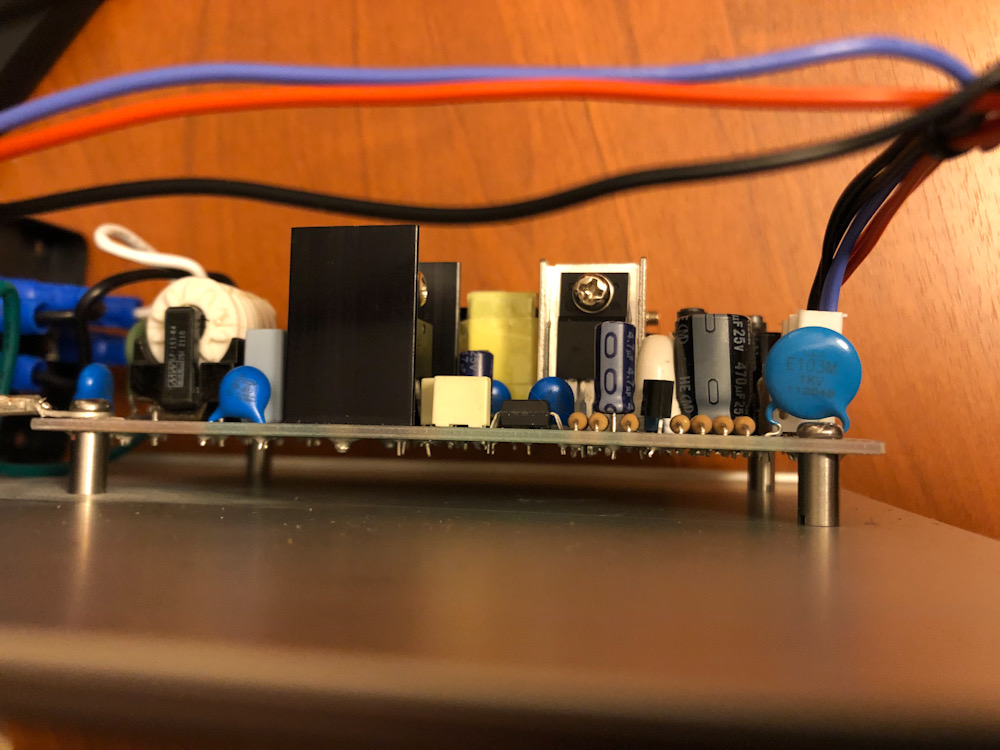
The power supply does its job.
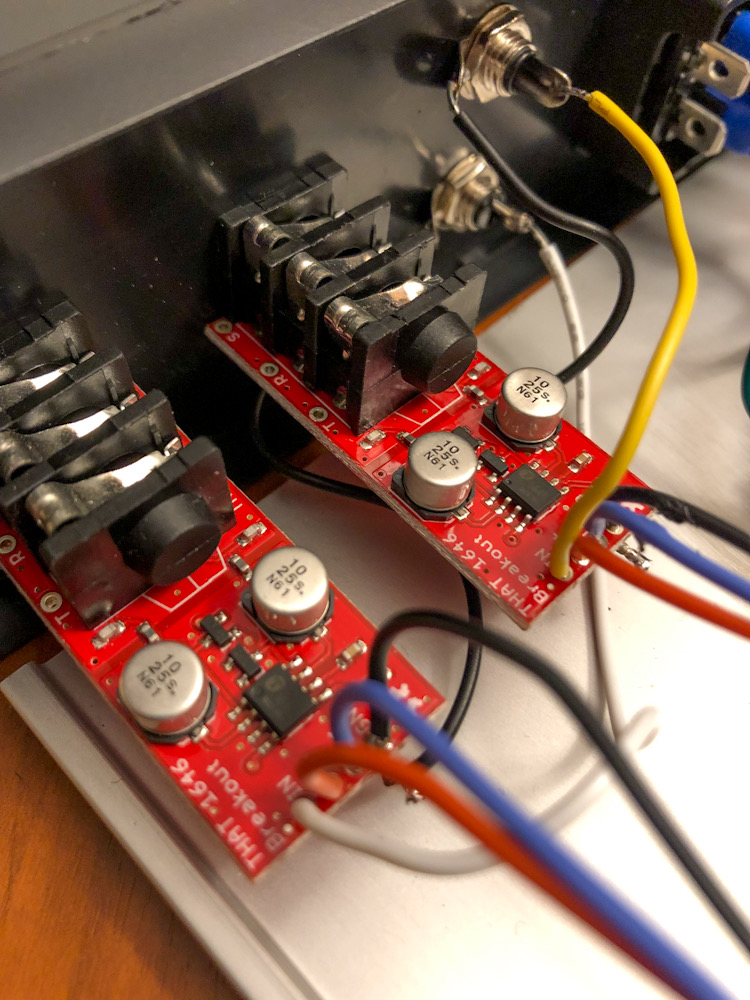
The Outsmarts modules use a THAT 1646 differential amplifier that creates a mirror image of the incoming waveform for the other side of the balanced connection. In so doing, it doubles peak-peak voltage, and therefore provides 6 dB of gain. It will produce a voltage swing up to two volts under the power-supply rails on each side. Thus, +/-15 VDC should provide 26 V p-p swing. My signal generator can do 20 V p-p, or 7.something V RMS. The Outsmarts models reproduced that perfectly as a differential pair.
The output receptacle (1/4” TRS phone plug) is part of the module, and the receptacle mount is what supports the module. I mounted it on the plastic end panel, same as the unbalanced-input RCA sockets. I left the balanced ground tied to the chassis ground (the module provides removable trace on the board to make this connection).
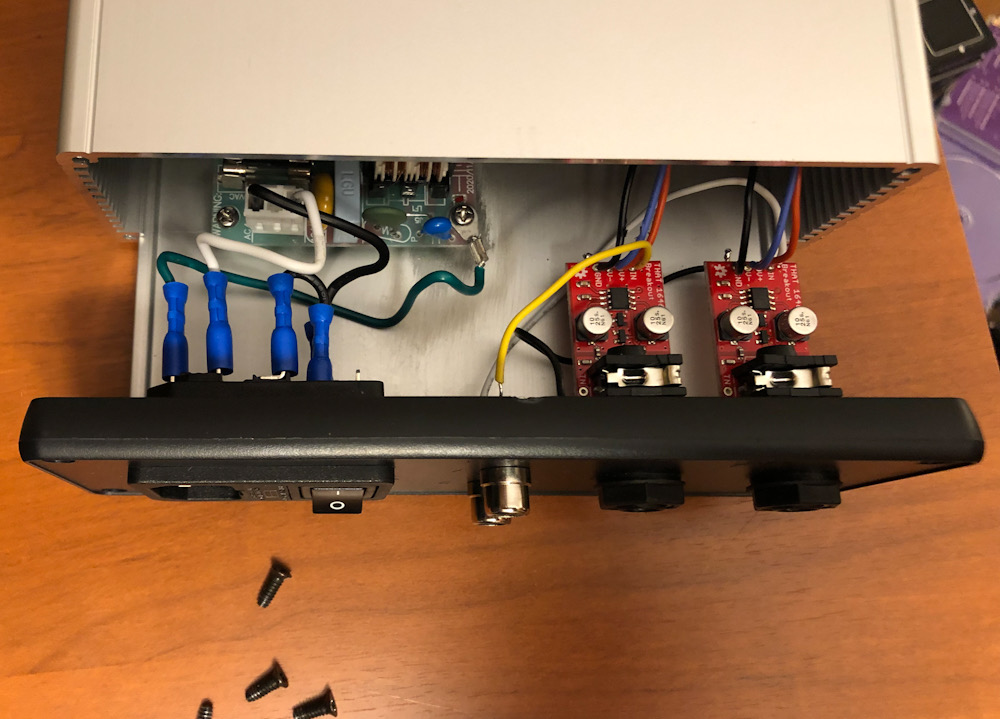
The case slides together and is surprisingly hefty.
Plugged without attenuation into my Buckeye NC502MP but with no inputs, it produced an audibly high noise level. Installing shorting plugs on the inputs made that noise disappear entirely. With shorted inputs, the Outsmarts modules are dead silent, even with my ear to the speaker.
My preamp doesn’t have a power switch, but instead switches the line-amp output either to the main outs or to the headphones. If I bypass the line amp, the headphone outputs don’t work. With the switch to phones, the preamp outputs float, and the noise comes back. I have to remember to turn the Buckeye off when listening to headphones (although I generally do this anyway—my headphones setup uses a line-level input from my dbx signal router to drive a JDS Labs Atom amp.)
Sparkfun also makes an input board that converts balanced inputs to unbalanced.
To me, this is a better solution than using an adapter cable, because it ensures sufficient drive even for low-gain amps. But mainly it means I can insert a balanced MiniDSP Flex between the Outsmarts device and the amp.
Rick “another step to the balanced Flex” Denney
https://www.audiosciencereview.com/...idsp-flex-review-audio-dsp.30804/post-1092076
I had already purchased a pair of Sparkfun Outsmarts differential amp modules, described at this link:
https://learn.sparkfun.com/tutorials/that-ingenius-and-outsmarts-breakout-hookup-guide
My plan had been to use the +/-15 V rails I thought I would find in my preamp. But the schematic I was working from was for something different than my B&K Sonata MC-101. It has +/- 28 VDC points. That’s too much for the Outsmarts modules that had been suggested to me in that thread. But I found a no-name DC-DC bipolar power supply that would accept any input from 15 to 36 VDC and provide +/-12 VDC.
Had I any intelligence, I would have tested that power supply thoroughly with a bulletproof lab power supply. I do not have any intelligence. I connected it to the 28 VDC point in the B&K board, saw a tiny spark, and fubarred my preamp
Each side of the 28 VDC regulation circuit uses a TIP31A power transistor, a 2N5210 transistor, a zener diode, and associated resistors. I removed the two transistors for testing, and the 2N5210 was definitely shorted. I found one of those and also a TIP31A and installed new replacements. That added a month to the project sourcing those parts—Mouser and Digikey were both out of stock but I found them at a supplier in Florida. But my work travel precluded installing them until this evening. Problem solved—the B&K is now unfubarred.
That’s when I decided the advice I’d been given in the above thread was correct—just build a standalone device with its own power supply.
So, in addition to the Outsmarts modules, I found a Meanwell +/-15 VDC switcher, and bought a case and the bits needed to stick it all together. Here’s the result:
This is what I call a minimalist control panel.
The two Outsmarts modules are at left, and the power supply is at right. I used an IEC receptacle with fuse and power switch. I ran earth safety ground to the grounding point on the power supply, which grounds the case through metal standoffs. (Yes, I wire-brushed the anodizing off.)
The power supply does its job.
The Outsmarts modules use a THAT 1646 differential amplifier that creates a mirror image of the incoming waveform for the other side of the balanced connection. In so doing, it doubles peak-peak voltage, and therefore provides 6 dB of gain. It will produce a voltage swing up to two volts under the power-supply rails on each side. Thus, +/-15 VDC should provide 26 V p-p swing. My signal generator can do 20 V p-p, or 7.something V RMS. The Outsmarts models reproduced that perfectly as a differential pair.
The output receptacle (1/4” TRS phone plug) is part of the module, and the receptacle mount is what supports the module. I mounted it on the plastic end panel, same as the unbalanced-input RCA sockets. I left the balanced ground tied to the chassis ground (the module provides removable trace on the board to make this connection).
The case slides together and is surprisingly hefty.
Plugged without attenuation into my Buckeye NC502MP but with no inputs, it produced an audibly high noise level. Installing shorting plugs on the inputs made that noise disappear entirely. With shorted inputs, the Outsmarts modules are dead silent, even with my ear to the speaker.
My preamp doesn’t have a power switch, but instead switches the line-amp output either to the main outs or to the headphones. If I bypass the line amp, the headphone outputs don’t work. With the switch to phones, the preamp outputs float, and the noise comes back. I have to remember to turn the Buckeye off when listening to headphones (although I generally do this anyway—my headphones setup uses a line-level input from my dbx signal router to drive a JDS Labs Atom amp.)
Sparkfun also makes an input board that converts balanced inputs to unbalanced.
To me, this is a better solution than using an adapter cable, because it ensures sufficient drive even for low-gain amps. But mainly it means I can insert a balanced MiniDSP Flex between the Outsmarts device and the amp.
Rick “another step to the balanced Flex” Denney
Last edited:

